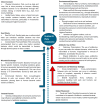Microbial Interconnections in One Health: A Critical Nexus Between Companion Animals and Human Microbiomes
- PMID: 40732073
- PMCID: PMC12299653
- DOI: 10.3390/microorganisms13071564
Microbial Interconnections in One Health: A Critical Nexus Between Companion Animals and Human Microbiomes
Abstract
The One Health approach is rapidly gaining the attention of the scientific community worldwide and is expected to be a major model of scientific reasoning in the 21st century, concerning medical, veterinary and environmental issues. The basic concept of One Health, that humans, animals and their environments are parts of the same natural world affecting each other, is rooted in most ethnic as well as in many religious traditions. Despite this unity and for historical reasons, medical, veterinary and environmental sciences developed independently. The One Health concept tries to reunite these and many other relevant sciences, aiming at a deeper understanding of the interconnection between the natural world, humans and animal health. The dynamic interplay between a host's microbiome, the microbiomes of other hosts, and environmental microbial communities profoundly influences the host health, given the essential physiological functions the microbiome performs within the organism. The biodiversity of microbiomes is broad and complex. The different areas of the skin, the upper and lower respiratory systems, the ocular cavity, the oral cavity, the gastrointestinal tract and finally the urogenital system of pets and humans alike are niches where a multitude of microorganisms indigenous and transient-commensals and pathogens, thrive in a dynamic antagonistic balance of populations of different phyla, orders, genera and species. The description of these microbiomes attempted in this article is not meant to be exhaustive but rather demonstrative of their complexity. The study of microbiomes is a necessary step towards the One Health approach to pets and humans. Yet, despite the progress made on that subject, the scientific community faces challenges, such as the limitations of studies performed, the scarcity of studies concerning the microbiomes of cats, the multitude of environmental factors affecting the results and others. The two new terms proposed in this article, the "familiome" and the "oikiome", will aid in the One Health theoretical analysis as well as in its practical approach. The authors strongly believe that new technological breakthroughs, like Big Data Analytics and Artificial Intelligence (AI), will significantly help to overcome these hazards.
Keywords: companion animals; human; microbiome; microbiota; one health; resistome.
Conflict of interest statement
The authors declare no conflicts of interest.
Figures


Similar articles
-
Short-Term Memory Impairment.2024 Jun 8. In: StatPearls [Internet]. Treasure Island (FL): StatPearls Publishing; 2025 Jan–. 2024 Jun 8. In: StatPearls [Internet]. Treasure Island (FL): StatPearls Publishing; 2025 Jan–. PMID: 31424720 Free Books & Documents.
-
Systemic Inflammatory Response Syndrome.2025 Jun 20. In: StatPearls [Internet]. Treasure Island (FL): StatPearls Publishing; 2025 Jan–. 2025 Jun 20. In: StatPearls [Internet]. Treasure Island (FL): StatPearls Publishing; 2025 Jan–. PMID: 31613449 Free Books & Documents.
-
The Black Book of Psychotropic Dosing and Monitoring.Psychopharmacol Bull. 2024 Jul 8;54(3):8-59. Psychopharmacol Bull. 2024. PMID: 38993656 Free PMC article. Review.
-
Home treatment for mental health problems: a systematic review.Health Technol Assess. 2001;5(15):1-139. doi: 10.3310/hta5150. Health Technol Assess. 2001. PMID: 11532236
-
A rapid and systematic review of the clinical effectiveness and cost-effectiveness of paclitaxel, docetaxel, gemcitabine and vinorelbine in non-small-cell lung cancer.Health Technol Assess. 2001;5(32):1-195. doi: 10.3310/hta5320. Health Technol Assess. 2001. PMID: 12065068
References
Publication types
LinkOut - more resources
Full Text Sources
Miscellaneous

